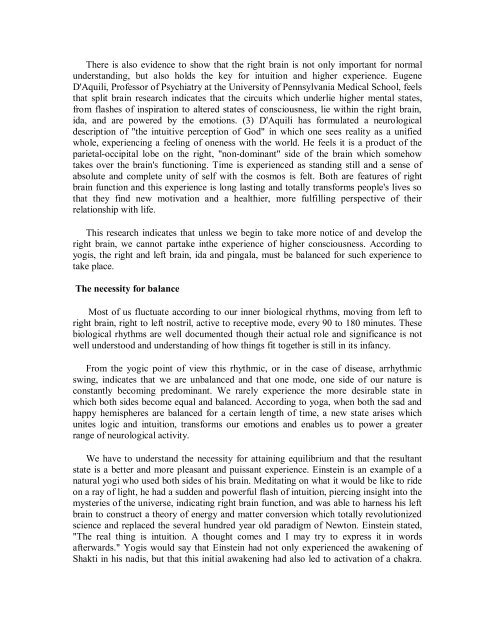Kundalini.Tantra.by.Satyananda.Saraswati
Create successful ePaper yourself
Turn your PDF publications into a flip-book with our unique Google optimized e-Paper software.
There is also evidence to show that the right brain is not only important for normal<br />
understanding, but also holds the key for intuition and higher experience. Eugene<br />
D'Aquili, Professor of Psychiatry at the University of Pennsylvania Medical School, feels<br />
that split brain research indicates that the circuits which underlie higher mental states,<br />
from flashes of inspiration to altered states of consciousness, lie within the right brain,<br />
ida, and are powered <strong>by</strong> the emotions. (3) D'Aquili has formulated a neurological<br />
description of "the intuitive perception of God" in which one sees reality as a unified<br />
whole, experiencing a feeling of oneness with the world. He feels it is a product of the<br />
parietal-occipital lobe on the right, "non-dominant" side of the brain which somehow<br />
takes over the brain's functioning. Time is experienced as standing still and a sense of<br />
absolute and complete unity of self with the cosmos is felt. Both are features of right<br />
brain function and this experience is long lasting and totally transforms people's lives so<br />
that they find new motivation and a healthier, more fulfilling perspective of their<br />
relationship with life.<br />
This research indicates that unless we begin to take more notice of and develop the<br />
right brain, we cannot partake inthe experience of higher consciousness. According to<br />
yogis, the right and left brain, ida and pingala, must be balanced for such experience to<br />
take place.<br />
The necessity for balance<br />
Most of us fluctuate according to our inner biological rhythms, moving from left to<br />
right brain, right to left nostril, active to receptive mode, every 90 to 180 minutes. These<br />
biological rhythms are well documented though their actual role and significance is not<br />
well understood and understanding of how things fit together is still in its infancy.<br />
From the yogic point of view this rhythmic, or in the case of disease, arrhythmic<br />
swing, indicates that we are unbalanced and that one mode, one side of our nature is<br />
constantly becoming predominant. We rarely experience the more desirable state in<br />
which both sides become equal and balanced. According to yoga, when both the sad and<br />
happy hemispheres are balanced for a certain length of time, a new state arises which<br />
unites logic and intuition, transforms our emotions and enables us to power a greater<br />
range of neurological activity.<br />
We have to understand the necessity for attaining equilibrium and that the resultant<br />
state is a better and more pleasant and puissant experience. Einstein is an example of a<br />
natural yogi who used both sides of his brain. Meditating on what it would be like to ride<br />
on a ray of light, he had a sudden and powerful flash of intuition, piercing insight into the<br />
mysteries of the universe, indicating right brain function, and was able to harness his left<br />
brain to construct a theory of energy and matter conversion which totally revolutionized<br />
science and replaced the several hundred year old paradigm of Newton. Einstein stated,<br />
"The real thing is intuition. A thought comes and I may try to express it in words<br />
afterwards." Yogis would say that Einstein had not only experienced the awakening of<br />
Shakti in his nadis, but that this initial awakening had also led to activation of a chakra.














![[Lonely Planet] Sri Lanka](https://img.yumpu.com/59845622/1/169x260/lonely-planet-sri-lanka.jpg?quality=85)


